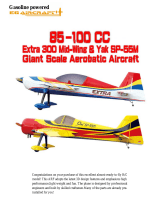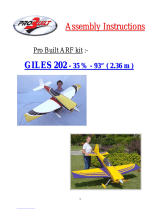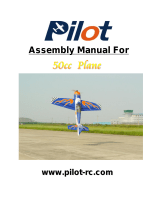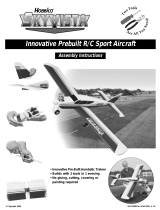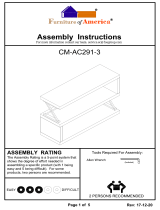Page is loading ...

1
150cc EXTRA 260 ARF-QB
(Quick Build)
ASSEMBLY MANUAL
AEROWORKS
401 Laredo St. Unit “D” - Aurora, CO. 80011
www.aero-works.net

2
TABLE OF CONTENTS
Page
Aeroworks Contact Information ………………………………………………………………. 3
Introduction / Warranty…………………………………………………………………………. 4
Kit Contents……………………………………………………………………………………… 5
Items Needed To Complete ……………………………………………………………………... 8
Tightening and Re-shrinking The Covering ………………………………………………….. 9
Checking Seams and Color Overlaps for Good Seal / Sealing Hinge Gaps ………..……….. 10
Applying Clear Covering to The Leading Edge of Wings and Stabs………………………… 11
Wing Assembly………………………………………………………………….……………….. 14
Stab and Elevator Assembly……………………………………………………………………. 22
Rudder, Rudder Servos and Tail wheel Assembly …………………………………………… 28
Main Landing Gear, Gear Cuff and Wheel Pant Assembly …………………………………. 43
Engine, Muffler or Canister and Throttle servo installation……………..…………………... 51
Fuel Tank Assembly and Installation ………………………………………………………….. 70
Ignition Module and Radio Installation………………………………………………………... 74
Cowl Installation ………………………………………………………………………………… 82
Manual Choke Installation ……………………………………………………………………... 89
Final Cowl Assembly …………………………………………………………………………….. 91
Preflight Preparation …………………………………………………………………………….. 92
Decal installation ………………………………………………………………………………… 94
Center of Gravity / Control Throws ……………………………………………………………. 100
Preflight Check List ……………………………………………………………………………... 103

3
401 Laredo Unit D
Aurora, CO 80011
Phone: (303) 366-4205
Fax: (303) 366-4203
Website: www.aero-works.net
E-mail: [email protected]
Thank you for choosing the Aeroworks 150cc EXTRA 260 ARF-QB. We put great ef-
fort into making this plane the best model you will ever build and fly. We have provided
you with the highest quality kit and performance possible. We wish you great success
in the assembly and flying of your new Aeroworks 150cc EXTRA 260 ARF-QB.
!WARNING!
An R/C aircraft is not a toy! If misused, it can cause serious bodily harm and property
damage. Fly only in open areas, and AMA (Academy of Model Aeronautics) approved
flying sites. Follow all instructions included with your plane, radio, and engine.
Aeroworks manufacturing guarantees this kit to be free from defects in both material
and workmanship at the date of purchase. This warranty does not cover any component
parts damaged by use or modification. In no case shall Aeroworks liability exceed the
original cost of the purchased kit. Further, Aeroworks reserves the right to change or
modify this warranty without notice.
In that Aeroworks has no control over the final assembly or materials used for final as-
sembly, No liability shall be assumed nor accepted for any damage resulting from the
use by the user of the final user-assembled product. By the act of using the user-
assembled product, the user accepts all resulting liability.
We, as the kit manufacturer, have provided you with a top quality, thoroughly tested
kit and instructions, but ultimately the quality and fly ability of your finished model
depends on how you build it; therefore, we cannot in any way guarantee the
performance of your completed model, and no representations are expressed or
implied as to the performance or safety of your completed model.

4
INTRODUCTION
Your new 150cc EXTRA 260 ARF-QB is a highly aerobatic airplane. It is capable of both
precision and 3-D maneuvers. The aircraft builds easily, quickly, and precisely due to its
state of the art CAD design, LASER cut technology, and high quality included hardware.
We hope you enjoy building and flying your 150cc EXTRA 260 ARF-QB.
Great care has been taken in both the design and manufacturing of the 150cc EXTRA 260
ARF-QB to allow for the strongest and lightest construction possible. Only the highest qual-
ity materials from the covering, paint, wood and hardware have been used in the construction
of this model.
The 150cc EXTRA 260ARF-QB has been individually hand built, covered and painted by
trained and experienced craftsmen with over 25 years of manufacturing experience. Using
CAD design, laser cut technology and jig-built assures accuracy in all stages of production.
The 150cc EXTRA 260ARF-QB is designed for gas engines in the 150cc category. The
DA-150cc engine is shown in the assembly instructions. The aircraft was tested with the
DA-150cc and has outstanding performance. The final choice of engine is left up to the
builder. A computer radio is recommended to allow the pilot to take advantage of the full
capabilities of this aerobatic aircraft.
IMPORTANT
Please read through this assembly manual carefully, before starting the as-
sembly of your new 150cc EXTRA 260ARF-QB . Inventory and inspect all parts and hard-
ware for any imperfections or damage. Please notify Aeroworks immediately if there
are missing or damaged parts.
INTENDED USE
This plane should not be regarded as a toy. This is an aerobatic plane and is recommended for pilots
who are beyond the trainer-stage and are comfortable with flying an aerobatic sport plane.
READ! WARRANTY READ!
It is important to notify Aeroworks of any damage or problems with the model within 30
days of receiving your airplane to be covered under warranty. If you wish to return this air-
craft for any reason a 15% restock fee will be charged to the customer. In addition the cus-
tomer is responsible for all return shipping cost and all prior shipping cost will not be re-
funded. Parts will be exchanged or replaced once the original item is returned at the owner’s
expense. If you have any problems or questions, please contact Aeroworks.
Aeroworks cannot insure the skill of the modeler and cannot influence the builder during the
construction or use of this aircraft, and therefore, will not be accountable for any property
damage, bodily injury or death caused by this aircraft.
Aeroworks cannot insure the skill of the modeler and cannot influence the builder during the
construction or use of this aircraft, and therefore,
The purchaser/operator accepts all responsibility of any and all structural or
mechanical failures.

5
KIT CONTENTS
150cc EXTRA 260 ARF-QB
Basic Aircraft Parts:
Fuselage - vertical fin installed – covered, engine
box & firewall installed - fuel-proofed - pre drilled for
mounting of the tail wheel assembly.
(4) 8-32 blind nuts installed for main landing gear
(4) 4-40 blind nuts installed for the mounting of the
stab
(8) 4-40 blind nuts installed for the mounting of the
cowling
(2) 4-40 blind nuts installed for the mounting of
landing gear hatch cover
(4) 4-40 blind nuts installed for the mounting of the
bottom hatch cover of engine box
(1) Top hatch cover of engine box, pre installed by
(4) T2.6 x 10mm PWA wood screws
(1) Bottom hatch cover of engine box, pre installed
by (4) 4-40 x 10mm hex head style bolts
(1) Hatch cover for the landing gear –covered,
installed by (2) 4-40x16mm hex style bolts and
(2) 3mm flat washers
(1) Canopy base-painted, installed on the fuselage by
(4) 4-40 blind nuts and (4) 4-40x16mm hex style
bolts
(1) Tinted Canopy—glued on the canopy base and
painted
(4) #6 bonded washers for the mounting of the
canopy base
(4) 3mm split lock washers for the mounting of the
canopy base
(2) 3.5(o.d.) x 1250mm Antenna guide tube installed
(2) 3.5(o.d.) x 80mm rudder pull-pull exit tubes
installed
Left Wing with Aileron – covered: Pre-drilled for the
mounting of the control horns
(2) 8-32 blind nuts installed for the wing mounting.
(2) Aluminum anti-rotation dowels - installed pre-
drilled hole for cotter pin installation
(11) pin point hinges (glued) Read to fly
(3) Aileron servo pull strings installed
Right Wing with Aileron – covered: Pre-drilled for the
mounting of the control horns
(2) 8-32 blind nuts installed for the wing mounting.
(2) Aluminum anti-rotation dowels - installed pre-
drilled hole for cotter pin installation
(11) pin point hinges installed (glued) Read to fly
(3) Aileron servo pull strings installed

6
Horizontal Stabilizer with elevator assembly—covered
(12) six per elevator, pin point hinges (glued) -
Ready to fly
Elevators Pre-drilled for the mounting of the
control horns
Rudder with (8) pin point hinges (not glued) – covered
Rudder Pre-drilled for the mounting of the
hinges, control horns and tail wheel steering arm.
SUB ASSEMBLIES:
#1:
(1) Fiberglass Cowling- painted - top and bottom- with
pre installed engine baffling, (22) pre drilled
screw holes for attaching top to bottom
(14) 4-40 blind nuts installed for attaching top to bottom
(14) 4-40 hex style bolts for attaching top to bottom
(8) 4-40 x 16mm hex bolts for mounting cowl to fuse
(8) #6 bonded washers for mounting cowling
(8) 3mm split lock washer for mounting cowling
#2:
(1) 6mm 7075Aluminum Main Landing Gear -- painted
(2) 5 x 48mm Axle Bolts
(2) M8 lock nuts
(4) 5mm i.d. Wheel Collars with set-screws
(2) 115mm Dia. Main Wheels (Lite Type)
(4) 4-40x16mm hex style bolts for mounting wheel
pants
(4) 3mm flat washer for mounting wheel pants
(4) 3mm split ring lock washer for mounting wheel
pants
(4) 8-32x25mm hex head bolts for mounting main
landing gear
(4) 4mm flat washers for mounting main landing gear
(4) 4mm split ring lock washers for mounting main
landing gear.
#3:
(2) Wheel Pants- Painted- pre mounted- 1 Left and 1
Right--
(4) 4-40 blind nuts installed in the wheel pants, 2 per
side.
(2) Landing gear cuffs - 1 left and 1 right - painted -
pre installed
(4) 4-40 x 7mm hex head bolts for mounting cuffs
(4) 3mm flat washer for mounting cuffs
(4) 3mm split ring lock washer for mounting cuffs
#4:
(1) AW- Custom Carbon Tail Wheel Assembly
(1) Aluminum steering arm and mounting screws
(2) Steering springs
#5:
(1) 40mm O.D. x 1240mm Carbon wing tube
(1) 16mm O.D. x 230mm Carbon stab tube - Front
(1) 16mm O.D. x 460mm Carbon stab tube - Rear
(4) 8-32 x 25mm Hex head bolts for wing mounting
(4) #8 bonded washer for wing mounting
(4) 4mm split ring lock washers for wing mounting
(4) 4-40x16mm Hex style head bolts for stab mounting
(4) #6 bonded washer for stab mounting
(4) 3mm split ring lock washers for stab mounting
(4) 1.8mm cotter pins - Second method -wing mounting
for security
#6:
(6) 4-40 2-1/2” Two end threaded pushrod with nuts and
clevises for ailerons
(4) 4-40 3” Two end threaded pushrod with nuts and
clevises for elevators
(2) 4-40x300mm Threaded pushrod –Throttle and
Choke
(2) 4-40 solder coupler - Throttle and Choke
(2) 4-40 Metal clevises - Throttle and Choke
(12) Brass spacers – 6 for ailerons; 4 for elevators; 1 for
throttle; 1 for choke
(22) 4-40 Ball Links – 12 for ailerons; 8 for elevators; 1
for throttle; 1 for choke
(22) 4-40 x 16mm hex style bolts
(22) 4-40 lock nuts
(1) 16” Carbon tube- pushrod reinforcement
#7:
(2) 1x1500mm plastic coated pull-pull steel cable.
(4) 4-40 Metal R/C links with metal clevises and nuts
(4) 3.5 x 5mm brass pull-pull swaging tubes
(12) AW double control horns
(72) T2.6 x 16mm Phillips head mounting screws
(2) 4-40 Ball Links
(2) 4-40 x 16mm hex style bolts
(2) 4-40 lock nuts
#8:
(1)
1500cc (50 ounce) Gas Fuel Tank assembly (Fuel)
(1) 1000cc (34 ounce) Gas Fuel Tank assembly (Smoke)
(1) 4ft. large gas fuel line
(4) Brass barbs for fuel line
#9:
(2) Throttle – Choke servo mounting plates
(4) Engine mounting templates
(DA150, 3W150 - 157, ZDZ 160 and ZDZ J-160)
(1) pre cut balsa sheet for canister tunnel- (3 pcs /set)
(2) Canister mounting bracket - Plywood
(16) 11mm O.D. x 20mm silicon tubes – canister pipe
(4) Rubber grommets - fuel line guide
(2) Cowl templates - cutting Hot Air exit holes
(1) 160 x 140 x 6mm foam for the Fuel tank.
(1) 160 x 100 x 6mm foam for the Smoke tank
(2) 300 x 80 x 8mm foam for the receiver and battery
(10) 3mm Nylon ties- fuel line
(8) 8mm Nylon ties - fuel tank
(6) 356 x 12.5mm Velcro (one wrap) Strap - Receiver
-Batteries

7
#10: Ultracote™
(1) 600x300mm Midnight Blue #885 - Small repairs
(1) 300x300mm True Red #866- Small repairs
(1) 300x300mm White #870 - Small repairs
(1) 300x300mm Silver #881 - Small repairs
(1) 600x300mm Transparent covering -Sealing hinge
gaps
(2) 2500x20mm Transparent covering strip – Sealing
wing and stab leading edges
#11:
(24) 6.35mm machined aluminum engine stand
offs
#12:
(1) AW - Custom throw meter – measure control
surface deflection
#13:
(1) Custom -
Vinyl Decal Set
#14
(1) Assembly manual with picture folders on CD

8
Hardware:
ITEMS NEEDED TO COMPLETE
• 150cc gas engine with ignition, mufflers or
headers, with canisters or pipes, and all engine
mounting bolts, lock nuts, and washers.
• 5” Spinner and propeller of your choice
• 6 x aileron servos (min. 180 in./oz. Digital,
Metal gear)
• 2 or 3 x rudder servos (min. 180 in./oz each or
500 in./oz. total torque, Digital, Metal gear)
• 4 x elevator servos (min. 180 in./oz. Digital,
Metal gear)
• 1 x throttle servo (fast / reliable)
• 1 x choke servo (fast / reliable) (Optional)
• Servo extensions - Heavy Duty - (22 gauge min)
7 (2 Rudd) or 8 (3 Rudd) x 11” Y harness, 2 x
6,” 2 x 18”, 2 x 24”, 2 x 36”, 2 x 48”
• 2 Receivers (PCM)
• 2 x Receiver battery (min 6.0 volt / 1700ma)
• 1 x Ignition battery (min 4.8 volt / 1700ma)
Tools:
• Allen wrenches US and Metric.
• Dremel cutting disc and sanding drum tool
• Electric drill and selection of bits
• Flat head screwdriver
• Hobby heat gun
•
Hobby iron with protective sock
•
Masking tape
• Modeling knife
• Needle nose pliers or crimping tool
• Paper towels
•
Pen, pencil or felt tipped marker
•
Phillips screwdriver
• Ruler and tape measure
• Scissors
• T pins
• Waxed paper
• Wire Cutters
Adhesives:
•
15-30 Minute epoxy
•
Blue Loctite
• Epoxy mixing cups, sticks, brushes
•
CA kicker (optional)
• Thick and Thin CA
• Rubbing alcohol
• Wipes
!WARRING!
Some rubbing alcohols
may attack painted parts.

9
1. Open your kit slowly and take care not to dam-
age any parts of the kit. Remove all parts from
their plastic protective covers for inspection.
Before doing any assembly or installation of any
decals it is very important
to re-shrink or re-
tighten the already applied covering. Due to the
shipping process, heat and humidity changes
from different climates, the covering may be-
come lose and wrinkle in the sun. If you take the
time to re-tighten the covering, you will be re-
warded with a long lasting beautifully covered
model.
TIGHTENING AND RE-SHRINKING THE COVERING
2. Using your covering iron with a soft sock, gently
apply pressure and rub in the covering. If any
bubbles occur, your iron may be to hot. Reduce
heat and work slowly.
!IMPORTANT!
Go over any and all seams and color overlaps
with your iron to assure good adhesion of the
covering to the wood. This is especially im-
portant at the leading edges of the wings and
stabs.
3. If bubbles persist, use a small pin to punch holes
in the bubble to relieve trapped air and reheat.
4. Use your heat gun with extreme caution. Take
care not to apply too much heat to one area for
long periods of time. This may cause the trim
colors to over shrink and pull away leaving un-
sightly gaps on the color lines. The trim stripes
are especially vulnerable to over heating and
over shrinking.
5. You model is covered with Ultracote™ cover-
ing. In case of repairs, the colors are:
Midnight Blue #885
Silver #881
True Red #866
White #870
Tightening and re-shrinking the covering is now
complete
. However, this is a never ending
process and should be checked after each
flying session.

10
1. Go over all seams and color overlaps with your
sealing iron.
Note: Even if your models covering has no wrin-
kles out of the box it is still very important to
go over all seams and overlaps to make certain
they are sealed securely. This is especially
important at the leading edges of the wings and
stabs. We recommend checking the covering
after each flying session.
CHECKING SEAMS AND COLOR OVERLAPS FOR GOOD SEAL
SEALING HINGE GAPS
2. Use covering iron to ensure all edges, seams,
and color overlaps are securely sealed.
3. Sealing hinge gaps. This is an optional step
but is recommended.
Cut strips of the supplied clear covering to fit
the hinge gaps. Use covering iron to seal the
clear covering snugly into the bottom of the
hinge lines as shown for air tight hinge seals.
Note: The clear covering does have a transparent
protective backing. This must be removed
prior to applying heat and to the surface.
IMPORTANT:
It is the responsibility of the purchaser /
operator to check the covering seams and
overlaps for security and a good seal.
Aeroworks is not responsible for failure of
covering seams or overlaps during flight.
Note: If covering continues to lift apply a small
amount of thin CA underneath the covering.
Then using a clean rag apply pressure to secure.
One of the most important tools in your
flight box is a roll of clear tape. This can be
used at the field for fast and easy repairs of
the covering. Then once you have finished
flying the covering can be permanently
repaired.

11
1. In order to complete this step you will need:
Clear covering, Covering Iron, Scissors,
Rubbing Alcohol, and Paper towel.
APPLYING CLEAR COVERING TO THE LEADING EDGE OF WINGS
AND STABS
2. Clean the leading edge of each wing thoroughly
with rubbing alcohol in order to insure a clean
surface for the covering to stick to.
Note: Wing pictured in the following steps may
be a different color and model. However,
the procedure for applying the clear
covering to your model will be the same.
3. Seal the top and bottom of the leading edge
carefully to insure the covering is securely
attached to the wood underneath.
4. Lay out one of the pieces of covering next to the
leading edge of the wing in order to find the
correct length for it to be cut to.

12
5. Cut the covering even with the wing tip being
careful not to cut it to short.
6. Save the excess covering from both wings in
order to seal the leading edge of the horizontal
stabs later.
7. Remove the clear backing from the covering.
Note: Do not skip this step. There is a backing to
the covering. Take time to remove this
backing to get the correct adhesion to the
already applied covering.
8. Begin by tacking the covering in place at the
wing root. Pay close attention to insure that the
covering is centered top and bottom on the lead-
ing edge of the wing.

13
9. Using the same method as step 8 tack the cover-
ing to the tip of the wing once again keeping it
centered on the leading edge.
10. Once the covering has been tacked in place
work from the center out to secure the cover-
ing to the leading edge of the wing.
11. Clear covering is now fully applied.
Note: Clear covering is centered on trim
colors. Using the same method complete
the remaining wing and stabs
IMPORTANT
It is the users responsibility to check the
covering seams and overlaps for security
and a good seal. Aeroworks is not
responsible for failure of covering seams
or overlaps during flight.
This is a never ending process that
must be done after each flying
secession. Due to varying tempera-
tures and humidity changes from
day to day the covering will
continue to loosen and must be
maintained.

14
Aileron Servo Installation
1. The ailerons have been pre-hinged and glued to
the wing panels and are ready for flight. No
other steps are necessary for hinging. Clear
Covering is supplied for sealing the hinge gaps if
desired. However, due to the precisely aligned
and minimal hinge gap this step is optional.
Gather one wing panel, three aileron servos, two
11” Y harnesses, one 24” and one 36” servo
extension as shown below to begin the servo
installation.
Note: 6” extension will also be needed per wing
when connecting aileron servos to receiver.
WING ASSEMBLY
2. Layout the servos, extensions and Y harness on
the wing to test fit the installation and ensure
servo leads are the correct length.
Minimum recommended servo:
180 in. oz. / Metal geared / Digital
3. Attach the 36” extension to the outboard servo
lead and secure with safety wire, string, tape,
or other method. Ensure the connectors will
not come apart from vibration or light tension.
4. Remove the balsa stick with the pull string
from the outboard servo well as shown.

15
5. Fasten the pull string from the outboard servo
hole to the male connector of the servo exten-
sion.
6. Secure with tape so that the string pulls from
the front end of the connector
to assist in
drawing the servo wire through the wing
without hanging up inside the wing.
7. Draw the 36” servo extension of the outboard
servo through the wing and pull through the
wing root rib as shown.
8. Repeat this process for the middle servo using
the 24” extension. Then repeat the process
using the servo lead from the inboard servo.
When finished there should be a lead from
each servo extending out of the wing root rib
as shown.

16
9. Plug the male ends of the 24” and 36” exten-
sion into the female ends of one Y harness.
Next plug the male end of this Y harness into
the female end of the next Y harness. Last
plug the male end of the inboard servo into the
remaining female end of the Y harness as
shown.
10. Secure all Y harness connections with safety
wire, string, tape, or other method. Ensure the
connectors will not come apart from vibration
or light tension. Secure excess wire from Y
harness and extensions inside the wing root rib
using tape or Velcro as desired.
11. Install all three servos in servo wells with the
output shaft toward the leading edge of the
wing. Mark locations of servo mounting
holes. Use a 1/16 bit to drill servo mounting
holes.
12. Install servo with servo mounting screws.

17
13. Repeat mounting steps for other servos so that
all three aileron servos are mounted in bottom
of wing as shown.
Note: Servo output shaft should face towards the
wing leading edge.
Aileron Control Linkage Installation
1. Gather the aileron control linkage parts as shown
below. There are (3) 4-40 pushrods, (6) 4-40
ball link assemblies, (3) brass spacers, (3) left
and (3) right side control horns, and (18) wood
screws for each wing panel.
Note: There is also included a Carbon tube for
reinforcing the pushrod (not pictured). This
will be installed during a later step.
2. Assemble three pushrod and control horn
assemblies as shown. The ball link goes
between the left and right sides of the control
horn sides and is secured with a nylon lock nut.
IMPORTANT: The ball link for the root end
control horn goes in the bottom hole of the
horn. The ball link for the middle
horn goes in
the center
hole of the horn. The ball link for the
tip end
horn goes in the top hole of the horn.
This gives the correct offset to eliminate bind-
ing and twisting of the aileron.
Note: It will still be necessary to either program or
use a after market type Match Box system to
assure your servos will not bind or fight against
each other.
3. Correct installation of ball link and brass spacer
to servo arm shown below.
Improperly installed servo linkages can cause ser-
vos to strip and ailerons to flutter. Aileron flutter
can and will destroy your model instantly!

18
4. Install the servo arms facing toward the wing tip
as shown.
5. Align the control horns over the factory drilled
holes.
6. Use thick CA on each screw prior to
installing to lock screws in place
Note: CA glues have a fast drying time.
Remember to work quickly.
7. Align the left and right sides of the control
horns to the mounting holes and secure using
six wood screws as shown.

19
Carbon Reinforcement Tube
Installation
1. Gather the supplied carbon tube for
reinforcing the aileron pushrods.
8. Plug the servos into the receiver and turn on.
Ensure servos are centered and the servo arms
are parallel to the aileron hinge line. Adjust
the length of the pushrods so that the aileron is
at the neutral position when the servo arms are
parallel to the aileron hinge line. Ensure all
servos do not fight each other at center or
either end point at full deflection. Take advan-
tage of servo programmers and match boxes
available today to achieve best results. This
will help keep servos from binding and
causing possible aileron flutter.
2. Wrap masking tape around carbon tube for
marking the cut location.
3. Mark cut location onto carbon tube. Carbon
tube should fit between 4-40 ball link lock
nuts.
Note: Make sure lock nuts are tight so pushrod
length does not change.

20
5. Remove the 4-40 ball link from the control
horn.
4. Using a Dremel cut off wheel cut the carbon
tube to correct length.
Note: Seal ends of carbon tube with thin CA to
help prevent ends from splitting.
6. Remove the 4-40 ball link and lock nut from the
pushrod.
Note: Make sure lock nut against servo arm ball
link is tight so pushrod length will not change.
7. Slide carbon reinforcing tube over the 4-40
pushrod and reassemble ball link to pushrod end.
Note: Make sure lock nut against servo arm ball
link is tight so pushrod length will not change.
/

